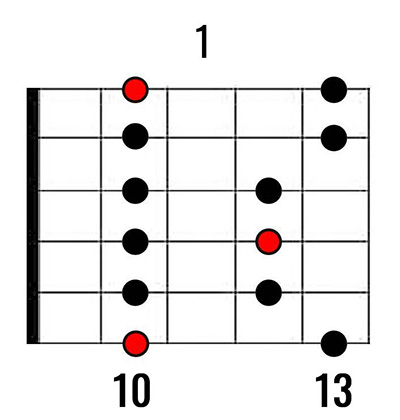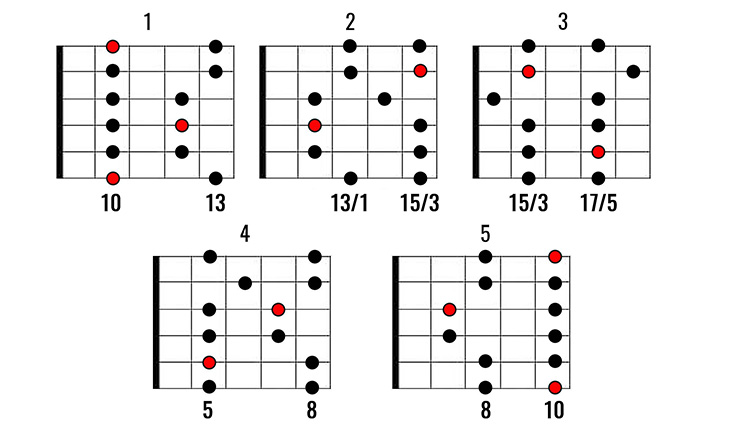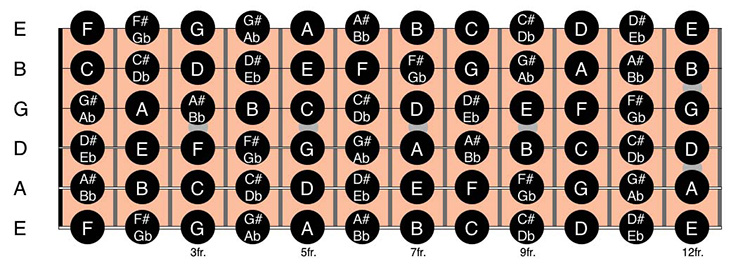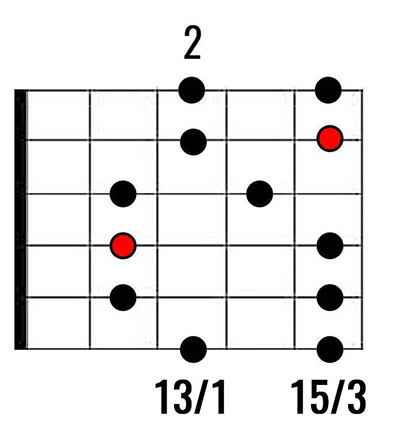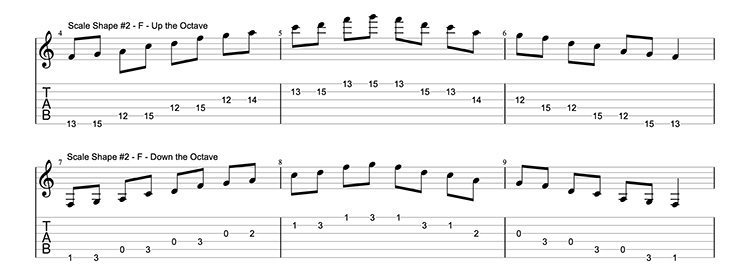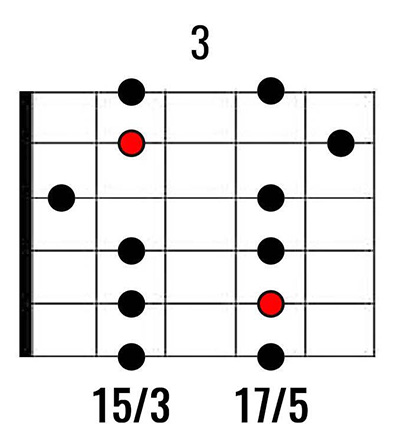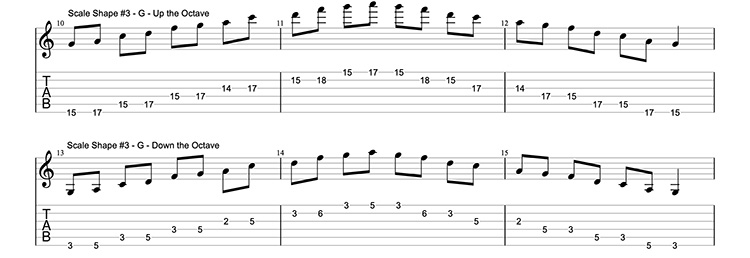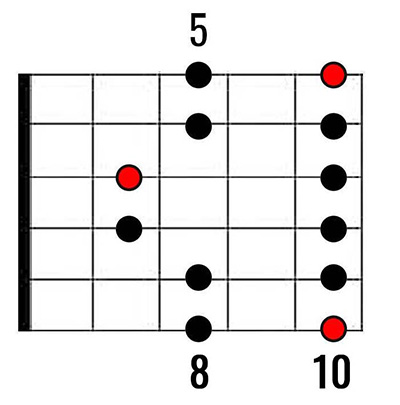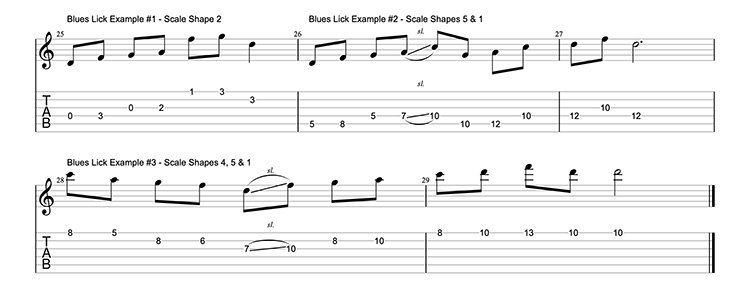The D minor pentatonic scale is one of the coolest guitar scales out there and is essential learning for any guitarist. In this free lesson we’ll show you everything you need to know about this epic scale.
Over 100,000 guitar-learners get our world-class guitar tips & tutorials sent straight to their inbox: Click here to join them
In this free lesson you will learn:
- 5 show-stopping pentatonic patterns.
- 3 must-know blues guitar licks that will make you sound incredible!
- The top-secret tip that will help you learn scales as quickly as possible.
What is a Pentatonic Scale?
The Pentatonic scale is a five-note scale that is used in ALL types of music. From pop to rock, the pentatonic scale can be seen and heard everywhere.
- The reason we refer to it as the ‘pentatonic’ scale is because it uses 5 notes. The term ‘penta’ means 5 in latin. And tonic means ‘note’.
- Therefore, this means that whenever you see the term ‘pentatonic’ it means that it’s a 5 note scale.
- The D minor pentatonic scale is often broken down into 5 different scale shapes.
These are known as ‘box’ patterns and throughout this guitar lesson we’re going to show you everything you need to know about this epic scale! Let’s dive in.
D Minor Pentatonic Scale – Root Position (D)
The first box shape of this scale begins on the 10th fret of the guitar.
- We should always lead with our index finger when playing the root position of any minor pentatonic scale.
- Assigning one finger to each fret of a scale shape helps us play smoothly without jumping around the fretboard.
Unfortunately, our middle finger gets left out of this shape, but we can position our other three fingers like so:
10th fret – Index
12th fret – Ring
13th fret – Pinky
Keep in mind, some scale shapes may require a one-fret jump either forward or backward.
- It’s good practice to let our index and pinky fingers handle these jumps to avoid straining our hands.
- Getting the pinky to the 13th fret can be difficult at first, so make sure you take your time when tackling those higher frets.
A great way to get that stretch underneath your belt is to practice picking back and forth on the 10th fret with your index, and the 13th with your pinky.
These two fingers will work together often over the course of your guitar journey, so it’s good practice to make sure that they’re familiar with each other.
Because the pinky finger has less practical use in the world outside of music, it won’t have as much strength in it initially.
We can easily take care of that through practice, so keep picking up that guitar!
It's hard to understand which scales work with which keys.
So we created a cheat-sheet! A key and scale-finder that you can use again and again.
Get a custom guitar-learning plan here: Click here for GuitarMetrics™ Learn from the world's best guitar educators: Click here for our guitar coursesDownload our lead guitar cheat-sheet to make things easier

Get your personalised guitar-learning plan 🎸
World-Class Guitar Courses 🌎
D Minor Pentatonic Scale – When to Use It
The D minor pentatonic scale has a variety of uses across genres like Jazz, Pop, Blues and even Rock & Metal.
- The key of D Minor is said by many musicians to be the saddest, and often the darkest key in music.
- This makes it great for sad ballads as well as emotional and aggressive rock songs alike.
The notes of the D minor pentatonic scale are as follows:
D – F – G – A – C
The chords in the key of D minor itself are:
- D minor.
- E diminished.
- F major.
- G minor.
- A minor.
- Bb major.
- C major.
Playing this scale over any combination of the chords above will provide us with a spread of darker textures to create some very moody music.
We can use the D minor pentatonic scale over a variety of keys including D minor, F major and D major.
Lead Guitar Tip!
Due to the fact that the D minor pentatonic scale has no sharp or flat notes, it can be played over chords in the key of C major, which also do not possess any sharps or flats.
What Are The Five Boxes of The D Minor Pentatonic Scale?
The D minor pentatonic scale can be broken down across the fretboard into five scale boxes.
- Breaking down scales in this way helps us create a mental map of the fretboard, which helps us with memorization.
- It’s important to note that each one of these scale shapes begins on a different note of the D minor pentatonic scale.
The notes of the D minor pentatonic scale are:
- D.
- F.
- G.
- A.
- C.
When trying to find the five boxes of the pentatonic scale, the easiest way to think of it is like this:
- The 1st position starts on the first note of the scale.
- The 2nd position starts on the second note of the scale.
- The 3rd position starts on the third note of the scale.
- The 4th position starts on the fourth note of the scale.
- The 5th position starts on the fifth note of the scale.
These starting notes all occur on the low E string.
When we put this into context with our D minor pentatonic scale, our scale positions look like this:
- 1st position: starts on a D note on the 10th fret.
- 2nd position: starts on an F note on the 13th or 1st fret.
- 3rd position: starts on a G note on the 15th or 3rd fret.
- 4th position: starts on a A note on the 5th fret.
- 5th position: starts on a C note on the 8th fret.
It’s easy to get lost on the fretboard when you’re starting out, so we’ve included all 5 positions of the D minor pentatonic scale to help you out:
You can also find other combinations of notes by learning your notes of the scale and then finding them by searching through this handy fretboard map.
Now we’ve talked about what the 5 pentatonic positions are, let’s learn each shape in more detail.
D Minor Pentatonic Scale – Box Shape #2 (F)
This scale shape is great for working on finger independence, so practice it often and slowly.
- We can begin with our middle finger on the 13th fret, and move to the 15th with our pinky.
- If you have a guitar with only 12 frets, this scale shape can be played starting at the 1st fret.
- The 12th fret notes can be played using open strings.
This scale shape also sees us introduce the ring finger on the 14th (or 2nd) fret, so make sure each finger has its own assigned fret.
Check out the scale shape below:
Always remember to practice these scales up and down.
We refer to this process as ascending and descending the scale.
- Remember to lead with your middle finger in this shape to keep that index finger open for the 12th fret.
- If you’re playing at the first fret, you won’t need your index at all.
The tablature is outlined for you below:
D Minor Pentatonic Scale – Box Shape #3 (G)
As we have already discussed, sometimes we require five frets to play a scale shape.
Given that we can’t really use our thumb, the only solution is to step up or down to that extra fret with our outside fingers (index and pinky).
The third shape of the D minor pentatonic scale requires us to make this step, so make sure you’ve stretched!
If you haven’t noticed, we push stretching a lot, and for good reason. It’s important for us as guitarist to stay flexible and healthy.
Check out the scale shape below:
We should lead with our middle finger at the third fret in this shape to leave our index to step back to the 2nd finger.
- Everything is fairly straightforward, with our pinky finger handling the work on the 5th fret until the B string.
- Once we hit the B string, our index finger should step up to the 3rd fret, letting us extend our pinky to the 6th fret without any strain.
Skill Tip: For the beginner guitarist, you might experience some discomfort at first when playing this scale shape. It’s important to take breaks to let your hands, wrists, joints and forearms rest and recover.
Things we suggest during your downtime from guitar:
- Stretch.
- Go for a walk.
- Think about playing guitar and watch cool YouTube videos to get you inspired.
Check out the tab below:
Lead Guitar Tip!
For the guitarist with pedals – setting a chorus and delay while playing this scale will create a creepy undertone that plays on the nature of the scale itself.
D Minor Pentatonic Scale – Box Shape #4 (A)
You will find that some scale shapes can closely resemble others.
This is the case with the fourth shape of the D minor pentatonic scale, as it resembles the root position.
The two main differences lie on the A string and the B string – can you see them?
- On the A string, we will use our pinky on the 8th fret instead of our ring finger.
- On the B string, we will use our middle finger on the 6th fret instead of our index at the 5th.
The scale shape can be seen below:
This scale shape can be a workout at first, so as always: take your time.
It’s very true that slow and steady wins the race in music.
Skill Tip: Each scale shape begins on a different note of the D minor pentatonic scale, as you have seen. This provides us with five slightly different arrangements of the same five notes. Say the note order out loud as you play the scale to help you memorize them all.
The note order in this scale shape is A – C – D – F – G.
We’ll give you a hint for the next one: It starts on C.
D Minor Pentatonic Scale – Box Shape #5 (C)
Our fifth and final shape of the D minor pentatonic scale begins at the 8th fret.
- This is a scale shape that leans heavily on our middle and pinky fingers.
- We will want to lead with our middle finger for this scale shape to once again leave room to step backward on the D and G strings.
- Practicing this shape frequently will lead to better finger strength and flexibility.
This concept is more commonly referred to as dexterity.
Let’s look at the scale shape below:
Our top-most note in this scale shape on the high E string is a D.
This means that we have now successfully played every note in the D minor pentatonic scale in every position on the fretboard. Congratulations!
Let’s have a look at the tab below to see how we can ascend and descend this scale shape:
Now that we know where the notes are and what the positions look like, we can begin to connect the dots with a few different D minor pentatonic licks.
Let’s do that now.
Learn 12 EASY beginner chords with our popular guide

✅ Stop struggling. Start making music.
✅ Learn beginner-friendly versions of every chord.
This is our most popular guide and it will improve your chord ability quickly! 😎
Get your own personalised guitar-learning plan 🎸
Get a custom guitar-learning plan here: Click here for GuitarMetrics™
World-Class Guitar Courses 🌎
Learn from the world's best guitar educators: Click here for our guitar courses
Connecting The Shapes of the D Minor Pentatonic Scale
Although scale shapes are important to learn, they aren’t really musical all by themselves.
Connecting the scale shapes and creating riffs out of different note combinations is what makes these scales begin to sing, so don’t be afraid to experiment to see what sounds good to your ears!
This is also how many famous songs were created, including Sweet Child o’ Mine by Guns N Roses.
If Slash can write a timeless, Billboard-topping rock and roll song out of practicing a guitar scale, then so can you!
In this example of the D minor pentatonic scale, we are going to begin in scale shape #5 and move our way into the root position.
- We begin on the 8th fret on the low E string and play our way up the scale until we slide from the 10th fret to the 12th on the D string.
- This slide brings us into the root position where we continue to ascend up to the high E string.
- Watch out for the drop to the 8th fret and the slide back up in the last bar.
These riffs are written in 8th notes, so they should be counted and played “1 & 2 & 3 & 4 &”
Now, let’s play some blues licks using everything we know!
Classic D Minor Pentatonic Blues Licks
- We’ve got three killer blues licks for you today that will fit over (almost) every D minor pentatonic chord progression possible.
- Our first example is a short, one-bar burst in scale shape #2.
It’s important to get familiar with using the open strings we have available to us when soloing, so take note of the open D and G strings in this one.
The challenge in this lick is skipping the B string to hit the high E at the first fret, and then stepping down to the B string after.
Skipping strings can be tricky, but anything is doable with practice. Don’t quit!
The next two examples focus on connecting scale shape 5 to the root position, which is important.
- These licks all have a feeling of resolution to them, as they all finish on the root note D.
- Example #2 is a three-string run that requires a bit of back-and-forth motion in the second bar, so make sure to use alternate picking to get through this lick.
- Make sure you use your pinky to get to the 8th fret, and slide from the 7th to the 10th to get from shape 5 to the root position.
The same rules apply for Example #3, where we descend the D minor pentatonic scale in shape 4 and move through shape 5 to get to the root position once again.
Remember, time and practice are always the greatest teachers.
Where do I go from here?
Want more out of your daily practice routine? We recommend:
- Pick up a copy of the Guitar Scales Handbook
- Find new jam tracks to practice over on YouTube (Check out Quist)
- Say the name of every note as you play it to memorize them all.
- Practice every scale shape as often as you can.
- Practice soloing over chord progressions you’ve written in D minor.
Try: D minor – G minor – A minor
Recommended Resources
Want to keep getting better at guitar? Check out some of our free lessons below:
- Learn Guitar Scales in 8 Easy Steps
- What’s the Difference Between Sharps & Flats?
- Alternate Picking: The Ultimate Guide
- 5 Guitar Songs for Beginners
- Guitar Classes: An Ultimate Guide
What Type of Guitarist Are You?
Take our 60-second quiz & get your results: Take The Quiz
Join the world's best online guitar school 🌎
- Get your own personalised guitar learning plan (customised just for YOU).
- World-class online guitar courses. Learn at your own pace.
- Community Campus & Learning Forum - A friendly community! Connect with our team & students. 😊
- Beginner Song library with chordsheets, tabs and tips. (Songs suitable for all levels!)
- Regular live streams, seminars and Q&A sessions - Learn from world-class guitar educators. Get all your questions answered!
Click here to learn more about National Guitar Academy membership 
Cool Guitar T-shirts 😎
Look cooler! Check out our merch: Click here to see our merch store
Want free guitar tips and video lessons delivered to your inbox?
Join over 100,000 guitar-learners and subscribe to our guitar-tips-by-email service. (It's free.)
We'll send you a series of lessons that will move you to the next level of your guitar journey.
Learn how everything fits together quickly, easily and effectively. We share ninja tips (for instant fun!) but also timeless fundamentals that will deepen your understanding.

Popular Lessons
How To Learn Guitar: An 11-Step Programme For Beginners
How To Choose The Perfect Beginner Guitar
More Cool Guitar Stuff
Learn about National Guitar Academy: About Us
Join us on Facebook for daily guitar tips.
Listen to our Learn Guitar Podcast for rapid guitar progress.
Check out our free chord lessons.
Get our best guitar tips & videos
Where should we send it?
Where should we send it?
Get our best guitar tips & videos


